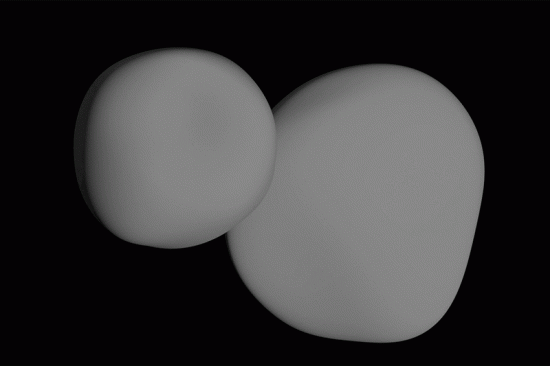
Mar 4, 2019
Ultima Thule continues to confound astronomers.
According to a recent press release, (486958) 2014 MU69, otherwise known as Ultima Thule, is not shaped like a snowman. The newest images from the New Horizons spacecraft reveal it to be a “squashed walnut” combined with a “flattened cookie”.
Alan Stern, a New Horizons mission specialist, wrote:
“The new images are creating scientific puzzles about how such an object could even be formed. We’ve never seen something like this orbiting the sun.”
NASA launched New Horizons January 19, 2006 on a mission to study the dwarf planet Pluto and its system of moons. The mission was re-purposed after the Pluto flyby, sending the probe speeding past Ultima Thule on New Year’s Day, 2019. It flew within 3500 kilometers of Ultima Thule, thought to be a an ancient remnant from the beginning of the Solar System. Astronomers believe that it might provide clues about how the Solar System evolved. However, its shape is not contained in their theoretical lexicon, so they are going back to the drawing board.
In many Picture of the Day articles, details about the origin of the Solar System in an electrical paroxysm are elaborated. The proposal is that compression from current flow through plasma initiates a z-pinch (or Bennett pinch) phenomenon, forcing material into a smaller and smaller volume, squeezing it into a characteristic distortion at right angles to the energy flow.
Illustrating how that electrical force molds objects into unfamiliar configurations are Saturn’s moons, Iapetus, Atlas and Pan.
Giovanni Cassini discovered Iapetus on October 25, 1671. However, it was nothing but a pinpoint of light for centuries, until September 10, 2007 when the Cassini orbiter passed within 1227 kilometers. In a previous Picture of the Day article, the resemblance to some earthly formations was noted. Specifically, the physical appearance of Moqui Marbles found in the deserts of Utah. The striking similarity can be seen in the equatorial ridges that are visible on both – stone balls as big as small eggs and a moon hundreds of kilometers in diameter.
Richard J. Terrile discovered Atlas after analyzing images returned by the Voyager 1 spacecraft during its flyby of Saturn on November 12, 1980. Atlas was named after one of the mythological Titans, the son of Iapetus. It is 40 kilometers long by 20 kilometers wide and rotates around its flattened plane. Atlas appears to act as a “shepherd moon”, and, along with Pan, are Saturn’s innermost moons, keeping to the A ring, sharpening the edges of the ring and maintaining its width.
Conventional theory proposes that Atlas and Pan formed through a process of accretion, originating as pieces of space debris captured by Saturn’s gravity. As they passed in and out of Saturn’s ring plane, its gravitational field attracted particles from the rings and deposited them on the moons’ surfaces. That “particulate drizzle” built-up the edges of both moons, creating their exceptional shapes and erasing any trace of cratering. It also left a uniformly thick deposit of dust, obscuring their “original” forms.
Ultima Thule probably conforms to similar events. Electric Universe theory states that, at some point in the past, Saturn experienced a violent upheaval that saw plasma discharges and incredibly intense auroral curtains sweep through the Solar System. Any celestial bodies within the range of the outburst would have been hammered by powerful currents, bombarded with intense radiation, heated and half-melted and then blasted with lightning bolts. All of that energy could have created the distinctive shapes of Iapetus, Atlas and Pan, as well as more remote objects that were electrically ejected into deep space, like Ultima Thule.
Stephen Smith












